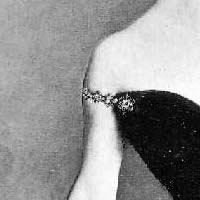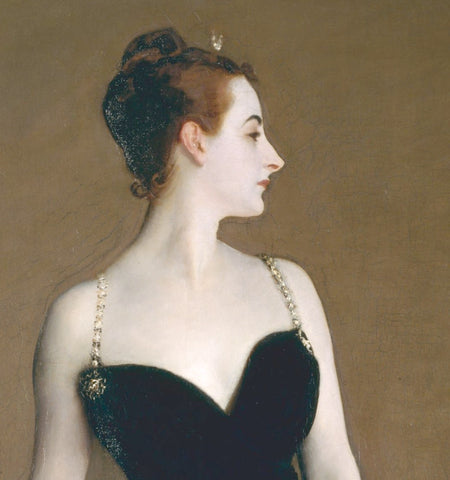Table of Contents:[hide]
1. Introduction
John Singer Sargent's "Madame X," also known as "Portrait of Madame X," is a captivating portrait that delves into the complexities of beauty and societal expectations. Let's unravel the layers of this iconic painting and delve into the scandal, execution, and aftermath that surround it.
2. The Controversial Creation
2.1 Background
Sargent's subject, Virginie Amélie Avegno Gautreau, a young socialite married to French banker Pierre Gautreau, became infamous in Parisian high society for her beauty and rumored infidelities. The unconventional beauty of Madame X made her a sought-after muse for artists, and Sargent, driven by a desire to attain high status in French society, embarked on a unique collaboration.
2.2 Studies
Sargent faced challenges in capturing Madame X's portrait as she was often distracted by social engagements. The artist traveled to her estate in Brittany, creating numerous preparatory works in various mediums. Despite the slow progress, Gautreau remained enthusiastic about the project.
2.3 Execution
Sargent strategically chose a large canvas for Madame X, creating a pose that emphasized tension and elegance. The painting process was meticulous, with Sargent using a specific palette to capture the artificial tone of Gautreau's pale skin. The result was a composition that highlighted both the assertiveness and the mystery in Madame X's persona.
3. Description
John Singer Sargent's "Madame X" transcends portraiture, blending assertion, and mystery. The canvas breathes with an aristocratic play of contrasts – the bold black dress, a mysterious brown backdrop, and the disconcerting expanse of unnaturally pale skin.
Sargent's deliberate pose for Gautreau reveals a duality, a subtle dance between assertion and retreat. Her profile, half-hidden yet defined, captures an upper-class allure. The table, echoing her curves, adds a layer of sensuality deemed suggestive for its time.
Originally exhibited with a fallen gown strap, the painting teased scandal and potential revelation. Critics speculated, unaware of the ornamental nature of Gautreau's gown structure. The erotic undertone, controlled yet distant, spoke of a sexuality under the sitter's professional facade, not for the viewer's pleasure.
Classical influences permeate "Madame X," as seen in poses reminiscent of Francesco de' Rossi's fresco figures. The table adorned with sirens from Greek mythology and Gautreau's crescent tiara embody subtle references, not contrived by the artist but integral to Gautreau's self-display.
In "Madame X," Sargent masterfully weaves an intricate narrative of allure, restraint, and classical homage, leaving viewers captivated by the layers of meaning embedded in this timeless masterpiece.
4. Reception and Aftermath
4.1 Immediate Reactions
The debut of John Singer Sargent's "Madame X" at the Paris Salon in 1884 ignited a storm of controversy, as immediate reactions veered sharply towards the negative. Sargent, present at the exhibition, experienced firsthand the tumultuous reception alongside Ralph Wormeley Curtis.
Curtis vividly recounted the chaotic scene, describing a "grande tapage [mob] before it all day," with jeers from women in response to Madame X's unveiling. Public sentiment overwhelmingly skewed towards disapproval, echoing cries of both admiration and horror.
Negative reviews swiftly inundated the art scene, notably from L’Événement, a French newspaper. The critique stated, "Mr. Sargent made a mistake if he thinks he expressed the shattering beauty of his model," citing a perceived lack of qualities and decrying the figure's "spineless expression" and "vulgar character."
Similar sentiments echoed in subsequent reviews, fixating on the perceived unattractiveness of Madame X. Critics juxtaposed the painting against Virginie Amélie Avegno Gautreau's reputation as a great beauty, lamenting her "pallid" and "corpse-ish" complexion.
Sexuality became a focal point of critique, with one critic from L'Artiste deeming Madame Gautreau the most intriguing among undressed women at the Salon due to the "indecency" of her dress. Lampooning ensued, as La Vie Parisienne published a caricature depicting Gautreau with exposed bosom, humorously defending her provocative attire.
Accusations of scandal manufacturing surfaced, with Art Amateur branding Madame X as "a wilful exaggeration of every one of his vicious eccentricities, simply for the purpose of being talked about and provoking argument."
4.2 Aftermath
John Singer Sargent's "Madame X" faced severe public backlash at the 1884 Paris Salon, leaving both the artist and his subject, Virginie Amélie Avegno Gautreau, distraught. Sargent's disappointment was palpable; his friend, Ralph Curtis, described him as "navré" or heartbroken on the opening day of the exhibition. Gautreau and her mother, bathed in tears, pleaded with Sargent to withdraw the painting, but he stood firm, defending his portrayal of Gautreau's unconventional beauty.

Undeterred by the initial controversy, Sargent took matters into his own hands. He overpainted the shoulder strap, addressing concerns about its provocative fall. The unfinished version, with the unresolved shoulder strap, remains housed in the Tate, London, a testament to the artistic process and the struggle against societal expectations.
Madame X, despite its tumultuous start, found a place in Sargent's studios in both Paris and London. Its journey continued as Sargent showcased it internationally from 1905 onwards, revealing a changing perception of the once-scandalous masterpiece. Interestingly, seven years after Sargent's portrait, Gustave Courtois painted Gautreau in a similar pose, this time receiving public acclaim. In 1897, Gautreau posed for another portrait, her favorite, by Antonio de La Gándara.
In 1916, Sargent parted ways with his masterpiece, selling it to the Metropolitan Museum of Art. In a letter to the museum's director, he expressed, "I suppose it is the best thing I have ever done." The New York Herald noted the art world's evolving response with the headline, "Sargent Masterpiece Rejected by Subject Now Acquired by Museum."
The legacy of Madame X continued to unfold in the 20th century. In 1960, designer Luis Estévez created a dress inspired by the painting, showcasing its enduring influence. The 1980s witnessed a revival of interest in Sargent's oeuvre, with "Portrait of Madame X" emerging as his best-known work. Today, the painting stands as a symbol of artistic resilience, challenging societal norms, and transcending initial controversies to become a timeless masterpiece.
5. Analysis
John Singer Sargent's "Madame X" stands as a provocative masterpiece, inviting scrutiny from art historians who dissect the societal norms of its era, especially those concerning sexuality and dress.
Dress historian Aileen Ribeiro contends that the black gown depicted in the portrait transcends scandal, suggesting it is so daring that even an actress might hesitate to wear it for a portrait. Valerie Steele, the Museum at FIT's curator, sheds light on the shocking nature of Madame X's dress for contemporary audiences, emphasizing the absence of underwear beneath the cuirass.
However, dress historian Justine De Young offers a contrasting view, asserting that criticism stems not solely from the dress but from how it was worn—with a slipped shoulder strap and heavy makeup. This debate underscores the multifaceted nature of the painting's controversy.
Art historian Dorothy Moss explores Sargent's emphasis on the sitter's artifice, a focal point that incited critics. Elizabeth Renes delves into Sargent's techniques, highlighting the dark background, sculptural pose, and simplicity of the gown that forced more flesh into view, challenging the ideal of naturalness prevalent during that time.
Susan Sidlauskas delves into the brazen self-display of Madame X, identifying reasons for audience offense—Gautreau's unique adornments, both sartorial and cosmetic, and her American ambitiousness. Sidlauskas suggests that Gautreau, through Sargent's lens, evoked audience anxieties with her carefully-styled appearance residing in an uncanny valley between life and death.
Deborah Davis, author of "Strapless: John Singer Sargent and the Fall of Madame X," notes the vocal disapproval from women, asserting moral superiority. Davis contrasts Madame X with nude paintings, emphasizing that Gautreau's identity, despite being technically obscured, was widely known. As a public figure and married woman, her suggestive appearance defied conventions more shockingly than anonymous nudes.
In conclusion, Madame X becomes a canvas not only for artistic expression but also for challenging societal norms, sparking debates that transcend the boundaries of art history. The controversy surrounding Madame X remains a testament to the power of portraiture in eliciting visceral reactions and challenging the established norms of its time.
6. Frequently Asked Questions (FAQs)
6.1 Q: Why was Madame X considered scandalous?
A: Madame X was considered scandalous due to the provocative nature of Gautreau's dress, her assertive pose, and the perceived violation of societal norms regarding feminine display.
6.2 Q: How did the public react to Madame X at the 1884 Paris Salon?
A: The public reaction was overwhelmingly negative, with jeers and criticism directed at the subject's appearance, dress, and the overall provocative nature of the painting.
6.3 Q: Why did Sargent modify the painting after the negative reception?
A: Sargent modified the painting to address the public's concerns, raising the fallen shoulder strap to make it look more securely fastened.
In conclusion, "Madame X" remains a timeless masterpiece that continues to captivate audiences, sparking discussions about beauty, societal norms, and the ever-evolving perceptions of art.
7. Prints and Canvas Panels
8. Related Articles
John Singer Sargent - Artist profile




